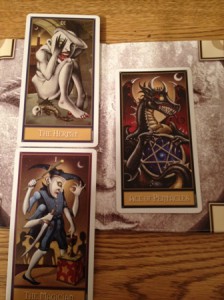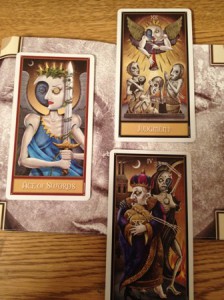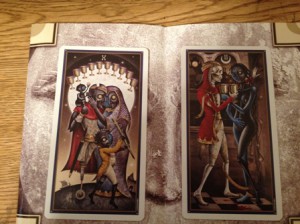I’ve posted before that I often turn to tarot for brainstorming (my friend Raelyn Barclay has lots of good posts here). What I’m finding (for me) is that I end up buying a new deck for each new idea. *sheepish*
For Lord Regret’s Price, I used the Steampunk Tarot exclusively. The gorgeous, rich artwork and the Victorian/steampunk elements really spoke to me. I hope I can continue to use those cards for other books in the series.
But when I sat down to work on the new paranormal idea, I didn’t want to use that same deck. It just didn’t work. It didn’t say masks or shifters or demons or anything spooky. I was wandering around on Amazon for something and saw the Deviant Moon deck and it was like cymbals started crashing in my skull. Yes, yes, yes!
Looking at the cards is even more exciting. I’ve been working with them all week with mixed results (so I thought). First, I used their recommended “deviant moon” spread for my villain and got some incredible ideas. Then I tried the same spread for the hero, and I just didn’t seem to feel it. I mean, the cards just didn’t seem connected. I couldn’t visualize anything, it didn’t spark a plot point, or anything.
When that happens, don’t despair! Here’s a few things I tried:
- I took notes anyway and saved them for later. Upon reflection and some shifting in my mind, the cards filled a gap for something else that I needed.
- Try a different spread. When all else fails, I go back to the simple 3-card past, present, and future. I got lots of good stuff for the hero then.
- If nothing seems to gel, maybe just flip through the deck and examine cards for fun. See which ones seem to speak and take notes.
All of these options paid out cool ideas this week. The cards I drew the first day that didn’t seem to work for the hero were actually calling up a missing character I needed. (They were all strong women, like the Empress, the Queen of Wands, but I knew it wasn’t the heroine.) I got another card that gave me a plot point that had nothing to do with the hero — but did involve the book.
And when I just picked some cards that really seemed important, I ended up building characters around those cards. I just KNEW they needed to be used because they were so cool. This time around, I’m actually building most of my cast straight from the cards themselves. Not all of the characters are a single card. e.g. the hero begins as a mix of the hermit/magician, but ends as the Ace of Pentacles. Without going into too many details about what I’m doing, here are a few pictures of how I’m pairing stuff up.
These cards represent my hero and heroine’s growth throughout the book. For the heroine (right), she has to make a choice. The bottom card is what will happen if she falls to the Dark Side. She’s quite dark, so while I know she’s not going to make that choice…I want to remind myself of that risk as I write.
For my villains (yes there’s more than one), I knew the card on the right was significant. It was a meeting between my two major antagonists. But I wasn’t sure where else she might show up. I flipped through the cards looking for a woman colored the same way to get other clues. I did the same thing for my heroine — looking for other cards that had wings.
So I guess my point here is that it doesn’t have to be based on random chance. You can sit down and look through the cards for specific characteristics to get ideas too.
Man, I’m loving this creepy weird deck! I’m getting so many wicked ideas!!!




Heh, I might ask to borrow your steampunk tarot sometime. You never know what it might spark. I still have that one story on the back burner, ya know!
Oooh, I have always loved using the Tarot for writing (I used to read the cards semi-professionally many moons ago). That deck looks awesome and very creepy. A deck I use a lot is the Roehrig Tarot which has some very unique imagery in it…it’s more of a surreal, dark, artsy kind of deck. Good luck with the story. I’m sure it will be awesome. 😀
Love this deck. It’s sitting, impatiently, on my Amazon wish list
Thanks for sharing your process here. I always learn something from you!
A new deck for each story idea…hmm, why didn’t I think of that? 😆
And thank you for the shout out.
Ooh, different decks for different stories is a good idea. I’d been thinking that the technique didn’t work for me, but it might jut be that my deck doesn’t work with that story.